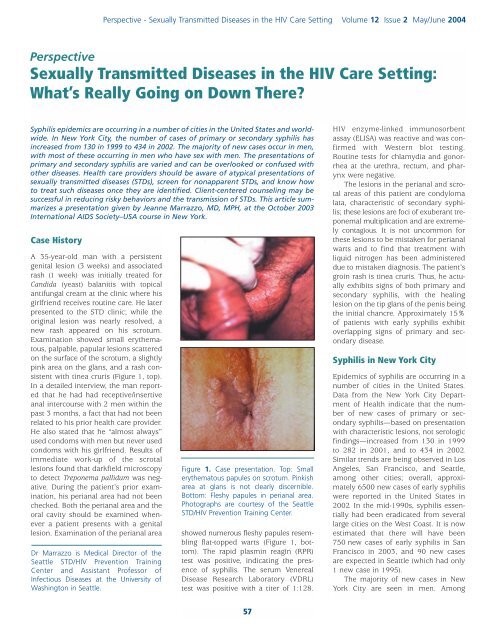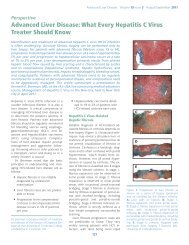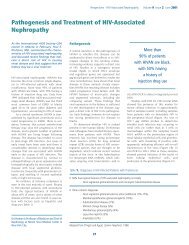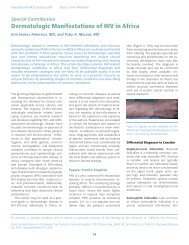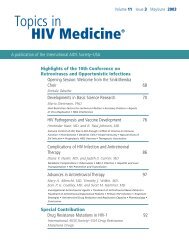Sexually Transmitted Diseases in the HIV Care Setting: What's ...
Sexually Transmitted Diseases in the HIV Care Setting: What's ...
Sexually Transmitted Diseases in the HIV Care Setting: What's ...
You also want an ePaper? Increase the reach of your titles
YUMPU automatically turns print PDFs into web optimized ePapers that Google loves.
Perspective - <strong>Sexually</strong> <strong>Transmitted</strong> <strong>Diseases</strong> <strong>in</strong> <strong>the</strong> <strong>HIV</strong> <strong>Care</strong> Sett<strong>in</strong>g Volume 12 Issue 2 May/June 2004<br />
Perspective<br />
<strong>Sexually</strong> <strong>Transmitted</strong> <strong>Diseases</strong> <strong>in</strong> <strong>the</strong> <strong>HIV</strong> <strong>Care</strong> Sett<strong>in</strong>g:<br />
What’s Really Go<strong>in</strong>g on Down There<br />
Syphilis epidemics are occurr<strong>in</strong>g <strong>in</strong> a number of cities <strong>in</strong> <strong>the</strong> United States and worldwide.<br />
In New York City, <strong>the</strong> number of cases of primary or secondary syphilis has<br />
<strong>in</strong>creased from 130 <strong>in</strong> 1999 to 434 <strong>in</strong> 2002. The majority of new cases occur <strong>in</strong> men,<br />
with most of <strong>the</strong>se occurr<strong>in</strong>g <strong>in</strong> men who have sex with men. The presentations of<br />
primary and secondary syphilis are varied and can be overlooked or confused with<br />
o<strong>the</strong>r diseases. Health care providers should be aware of atypical presentations of<br />
sexually transmitted diseases (STDs), screen for nonapparent STDs, and know how<br />
to treat such diseases once <strong>the</strong>y are identified. Client-centered counsel<strong>in</strong>g may be<br />
successful <strong>in</strong> reduc<strong>in</strong>g risky behaviors and <strong>the</strong> transmission of STDs. This article summarizes<br />
a presentation given by Jeanne Marrazzo, MD, MPH, at <strong>the</strong> October 2003<br />
International AIDS Society–USA course <strong>in</strong> New York.<br />
Case History<br />
A 35-year-old man with a persistent<br />
genital lesion (3 weeks) and associated<br />
rash (1 week) was <strong>in</strong>itially treated for<br />
Candida (yeast) balanitis with topical<br />
antifungal cream at <strong>the</strong> cl<strong>in</strong>ic where his<br />
girlfriend receives rout<strong>in</strong>e care. He later<br />
presented to <strong>the</strong> STD cl<strong>in</strong>ic; while <strong>the</strong><br />
orig<strong>in</strong>al lesion was nearly resolved, a<br />
new rash appeared on his scrotum.<br />
Exam<strong>in</strong>ation showed small ery<strong>the</strong>matous,<br />
palpable, papular lesions scattered<br />
on <strong>the</strong> surface of <strong>the</strong> scrotum, a slightly<br />
p<strong>in</strong>k area on <strong>the</strong> glans, and a rash consistent<br />
with t<strong>in</strong>ea cruris (Figure 1, top).<br />
In a detailed <strong>in</strong>terview, <strong>the</strong> man reported<br />
that he had had receptive/<strong>in</strong>sertive<br />
anal <strong>in</strong>tercourse with 2 men with<strong>in</strong> <strong>the</strong><br />
past 3 months, a fact that had not been<br />
related to his prior health care provider.<br />
He also stated that he “almost always”<br />
used condoms with men but never used<br />
condoms with his girlfriend. Results of<br />
immediate work-up of <strong>the</strong> scrotal<br />
lesions found that darkfield microscopy<br />
to detect Treponema pallidum was negative.<br />
Dur<strong>in</strong>g <strong>the</strong> patient’s prior exam<strong>in</strong>ation,<br />
his perianal area had not been<br />
checked. Both <strong>the</strong> perianal area and <strong>the</strong><br />
oral cavity should be exam<strong>in</strong>ed whenever<br />
a patient presents with a genital<br />
lesion. Exam<strong>in</strong>ation of <strong>the</strong> perianal area<br />
Dr Marrazzo is Medical Director of <strong>the</strong><br />
Seattle STD/<strong>HIV</strong> Prevention Tra<strong>in</strong><strong>in</strong>g<br />
Center and Assistant Professor of<br />
Infectious <strong>Diseases</strong> at <strong>the</strong> University of<br />
Wash<strong>in</strong>gton <strong>in</strong> Seattle.<br />
Figure 1. Case presentation. Top: Small<br />
ery<strong>the</strong>matous papules on scrotum. P<strong>in</strong>kish<br />
area at glans is not clearly discernible.<br />
Bottom: Fleshy papules <strong>in</strong> perianal area.<br />
Photographs are courtesy of <strong>the</strong> Seattle<br />
STD/<strong>HIV</strong> Prevention Tra<strong>in</strong><strong>in</strong>g Center.<br />
showed numerous fleshy papules resembl<strong>in</strong>g<br />
flat-topped warts (Figure 1, bottom).<br />
The rapid plasm<strong>in</strong> reag<strong>in</strong> (RPR)<br />
test was positive, <strong>in</strong>dicat<strong>in</strong>g <strong>the</strong> presence<br />
of syphilis. The serum Venereal<br />
Disease Research Laboratory (VDRL)<br />
test was positive with a titer of 1:128.<br />
<strong>HIV</strong> enzyme-l<strong>in</strong>ked immunosorbent<br />
assay (ELISA) was reactive and was confirmed<br />
with Western blot test<strong>in</strong>g.<br />
Rout<strong>in</strong>e tests for chlamydia and gonorrhea<br />
at <strong>the</strong> urethra, rectum, and pharynx<br />
were negative.<br />
The lesions <strong>in</strong> <strong>the</strong> perianal and scrotal<br />
areas of this patient are condyloma<br />
lata, characteristic of secondary syphilis;<br />
<strong>the</strong>se lesions are foci of exuberant treponemal<br />
multiplication and are extremely<br />
contagious. It is not uncommon for<br />
<strong>the</strong>se lesions to be mistaken for perianal<br />
warts and to f<strong>in</strong>d that treatment with<br />
liquid nitrogen has been adm<strong>in</strong>istered<br />
due to mistaken diagnosis. The patient’s<br />
gro<strong>in</strong> rash is t<strong>in</strong>ea cruris. Thus, he actually<br />
exhibits signs of both primary and<br />
secondary syphilis, with <strong>the</strong> heal<strong>in</strong>g<br />
lesion on <strong>the</strong> tip glans of <strong>the</strong> penis be<strong>in</strong>g<br />
<strong>the</strong> <strong>in</strong>itial chancre. Approximately 15%<br />
of patients with early syphilis exhibit<br />
overlapp<strong>in</strong>g signs of primary and secondary<br />
disease.<br />
Syphilis <strong>in</strong> New York City<br />
Epidemics of syphilis are occurr<strong>in</strong>g <strong>in</strong> a<br />
number of cities <strong>in</strong> <strong>the</strong> United States.<br />
Data from <strong>the</strong> New York City Department<br />
of Health <strong>in</strong>dicate that <strong>the</strong> number<br />
of new cases of primary or secondary<br />
syphilis—based on presentation<br />
with characteristic lesions, not serologic<br />
f<strong>in</strong>d<strong>in</strong>gs—<strong>in</strong>creased from 130 <strong>in</strong> 1999<br />
to 282 <strong>in</strong> 2001, and to 434 <strong>in</strong> 2002.<br />
Similar trends are be<strong>in</strong>g observed <strong>in</strong> Los<br />
Angeles, San Francisco, and Seattle,<br />
among o<strong>the</strong>r cities; overall, approximately<br />
6500 new cases of early syphilis<br />
were reported <strong>in</strong> <strong>the</strong> United States <strong>in</strong><br />
2002. In <strong>the</strong> mid-1990s, syphilis essentially<br />
had been eradicated from several<br />
large cities on <strong>the</strong> West Coast. It is now<br />
estimated that <strong>the</strong>re will have been<br />
750 new cases of early syphilis <strong>in</strong> San<br />
Francisco <strong>in</strong> 2003, and 90 new cases<br />
are expected <strong>in</strong> Seattle (which had only<br />
1 new case <strong>in</strong> 1995).<br />
The majority of new cases <strong>in</strong> New<br />
York City are seen <strong>in</strong> men. Among<br />
57
International AIDS Society–USA Topics <strong>in</strong> <strong>HIV</strong> Medic<strong>in</strong>e ® Figure 3. Secondary syphilis. Top: Classic<br />
Figure 2. Primary syphilis <strong>in</strong> men may have<br />
a number of presentations, <strong>in</strong>clud<strong>in</strong>g <strong>the</strong><br />
classic chancre (top) or a small non<strong>in</strong>flammatory<br />
lesion (bottom). Photographs are<br />
courtesy of <strong>the</strong> Seattle STD/<strong>HIV</strong> Prevention<br />
Tra<strong>in</strong><strong>in</strong>g Center.<br />
patients who were <strong>in</strong>terviewed, <strong>the</strong><br />
number of syphilis cases occurr<strong>in</strong>g <strong>in</strong><br />
men who have sex with men <strong>in</strong>creased<br />
dramatically from 2000 to 2002. Among<br />
men with known <strong>HIV</strong> status, <strong>the</strong> proportion<br />
of new syphilis cases occurr<strong>in</strong>g<br />
<strong>in</strong> <strong>HIV</strong>-<strong>in</strong>fected men <strong>in</strong>creased from<br />
20% <strong>in</strong> 1999 to 61% <strong>in</strong> 2002.<br />
There are likely a number of factors<br />
contribut<strong>in</strong>g to <strong>the</strong> resurgence of<br />
syphilis. In <strong>the</strong> <strong>HIV</strong>-<strong>in</strong>fected community,<br />
<strong>in</strong>creased survival and well-be<strong>in</strong>g result<strong>in</strong>g<br />
from effective antiretroviral <strong>the</strong>rapy<br />
have been associated with a return to<br />
normal activities, <strong>in</strong>clud<strong>in</strong>g sexual activities.<br />
Many at-risk <strong>in</strong>dividuals erroneously<br />
believe that <strong>HIV</strong> disease is now<br />
“curable” and that <strong>HIV</strong> cannot be transmitted<br />
when plasma <strong>HIV</strong> RNA levels are<br />
controlled on potent antiretroviral <strong>the</strong>rapy.<br />
There is also reduced visibility of<br />
end-stage AIDS, which, <strong>in</strong> <strong>the</strong> past, may<br />
have served as a deterrent to unsafe<br />
sexual practices. In addition, <strong>the</strong>re<br />
appears to be a general “fatigue” or<br />
“burnout” with regard to practic<strong>in</strong>g<br />
safer sex. O<strong>the</strong>r factors contribut<strong>in</strong>g to<br />
<strong>the</strong> rise <strong>in</strong> cases of syphilis may <strong>in</strong>clude<br />
<strong>in</strong>creased use of recreational drugs (eg,<br />
methamphetam<strong>in</strong>e [eg, crystal meth],<br />
nitrates [eg, poppers], and sildenafil citrate<br />
[Viagra]); <strong>the</strong> reemergence of old<br />
ways to meet anonymous partners (eg,<br />
baths, parks); and <strong>the</strong> emergence of<br />
new ways to meet partners (eg, Internet<br />
dat<strong>in</strong>g; <strong>in</strong> fact, <strong>in</strong> Seattle, a surpris<strong>in</strong>gly<br />
high proportion of new patients with<br />
syphilis reported meet<strong>in</strong>g <strong>the</strong>ir anonymous<br />
partners via <strong>the</strong> Internet).<br />
Presentation of Syphilis<br />
In men, primary syphilis may present<br />
as <strong>the</strong> classic chancre on <strong>the</strong> penile<br />
shaft (Figure 2). Typically, <strong>the</strong> chancre is<br />
pa<strong>in</strong>less and nontender to palpation, is<br />
<strong>in</strong>durated with a heaped-up border, and<br />
has a clean (nonpurulent) base. The<br />
lesion is RPR- or VDRL-positive <strong>in</strong><br />
approximately 70% of cases. However,<br />
primary disease does not always take<br />
<strong>the</strong> classic form; for example, <strong>the</strong> chancre<br />
may appear as a small, non<strong>in</strong>flammatory<br />
lesion (Figure 2). Only serologic<br />
evaluation or darkfield microscopy can<br />
provide a def<strong>in</strong>itive diagnosis. Chancres<br />
can appear anywhere that <strong>in</strong>oculation<br />
has occurred via direct contact—eg, f<strong>in</strong>gers,<br />
mouth, and perianal area.<br />
Chancres <strong>in</strong> <strong>the</strong> perianal area are sometimes<br />
mistaken for genital herpes.<br />
Secondary syphilis can be protean<br />
<strong>in</strong> its manifestations, <strong>in</strong>clud<strong>in</strong>g presentation<br />
as a nephrotic syndrome, hepatitis,<br />
or febrile lymphadenitis. The classic<br />
presentation is a macular rash on <strong>the</strong><br />
palm of <strong>the</strong> hand or sole of <strong>the</strong> foot<br />
(Figure 3, top); differential diagnosis of<br />
<strong>the</strong> rash <strong>in</strong>cludes Rocky Mounta<strong>in</strong> spotted<br />
fever and drug reactions. The rash is<br />
highly contagious. As noted, condyloma<br />
lata (Figure 1) are also characteristic of<br />
<strong>the</strong> secondary stage, and are often confused<br />
with condyloma acum<strong>in</strong>ata result<strong>in</strong>g<br />
from <strong>in</strong>fection with human papilloma<br />
virus (HPV) types 6/11. Condyloma<br />
lata can occur at any moist body<br />
site. Their fleshy, flat-topped appearance<br />
may help to dist<strong>in</strong>guish <strong>the</strong>m from<br />
HPV-associated warts, which are less<br />
fleshy and more verrucous. Anal sex is<br />
not a prerequisite for perianal condyloma<br />
lata or HPV-associated warts.<br />
Secondary syphilis may also appear as<br />
mucous patches on <strong>the</strong> background of<br />
a “coated” tongue (Figure 3, bottom).<br />
These lesions conta<strong>in</strong> large numbers of<br />
treponemes and are also highly contagious.<br />
The patches can be confused with<br />
oral hairy leukoplakia. RPR test<strong>in</strong>g and<br />
VDRL test<strong>in</strong>g are positive <strong>in</strong> almost<br />
100% of cases of secondary syphilis.<br />
Genital Herpes<br />
Approximately 45 to 60 million <strong>in</strong>dividuals<br />
<strong>in</strong> <strong>the</strong> United States have genital<br />
herpes. The classic presentation of <strong>in</strong>itial<br />
<strong>in</strong>fection <strong>in</strong> men is that of vesicles<br />
on <strong>the</strong> penile shaft. However, <strong>the</strong><br />
presentation can also occur <strong>in</strong> forms<br />
that are difficult to dist<strong>in</strong>guish from <strong>the</strong><br />
chancres of syphilis; thus, presentation<br />
may occur as eroded ulcers suggestive<br />
of syphilis or as a s<strong>in</strong>gle ulcer with a<br />
clean base suggestive of syphilis. In<br />
women, presentation on <strong>the</strong> external<br />
genitalia often occurs as ulcers ra<strong>the</strong>r<br />
than as <strong>the</strong> classic vesicles. The specific<br />
diagnosis of genital herpes can be made<br />
by culture or direct antigen test, <strong>in</strong>volv<strong>in</strong>g<br />
swabb<strong>in</strong>g of a lesion. In some circumstances,<br />
herpes serology can also<br />
be a highly useful tool. Until about 3 or<br />
macular rash. Bottom: Mucous patches on<br />
“coated” tongue. Photographs are courtesy<br />
of <strong>the</strong> Seattle STD/<strong>HIV</strong> Prevention<br />
Tra<strong>in</strong><strong>in</strong>g Center.<br />
58
Perspective - <strong>Sexually</strong> <strong>Transmitted</strong> <strong>Diseases</strong> <strong>in</strong> <strong>the</strong> <strong>HIV</strong> <strong>Care</strong> Sett<strong>in</strong>g Volume 12 Issue 2 May/June 2004<br />
4 years ago, serum antibody tests that<br />
claimed to be specific for herpes simplex<br />
virus (HSV)-1 and -2 were not actually<br />
type specific, s<strong>in</strong>ce <strong>the</strong>y were not<br />
based on glycoprote<strong>in</strong> G. Glycoprote<strong>in</strong><br />
G-based serology kits are shown <strong>in</strong><br />
Table 1. Herpes serology can be used to<br />
confirm cl<strong>in</strong>ical diagnosis, especially<br />
when direct detection of virus is unlikely—that<br />
is, when lesions are negative<br />
for virus, when <strong>the</strong>y cannot be sampled,<br />
or when <strong>the</strong>y are healed or o<strong>the</strong>rwise<br />
not present. Most genital herpes cases<br />
are subcl<strong>in</strong>ical, with about 90% of people<br />
<strong>in</strong>fected with HSV-2 claim<strong>in</strong>g never<br />
to have had an outbreak. Serology is<br />
thus useful for detect<strong>in</strong>g cases of subcl<strong>in</strong>ical<br />
<strong>in</strong>fection <strong>in</strong> <strong>in</strong>dividuals at highrisk—for<br />
example, those with a partner<br />
who has genital herpes or those with<br />
o<strong>the</strong>r symptoms suggestive of atypical<br />
or undiagnosed genital herpes.<br />
How to Prevent <strong>Sexually</strong><br />
<strong>Transmitted</strong> <strong>Diseases</strong><br />
Crucial components <strong>in</strong> prevent<strong>in</strong>g transmission<br />
of STDs <strong>in</strong>clude prompt identification,<br />
effective treatment of <strong>in</strong>fections,<br />
and appropriate risk counsel<strong>in</strong>g. Health<br />
care providers must be aware of epidemiologic<br />
trends so that nonapparent<br />
STDs or cases with atypical presentations<br />
can be identified. Assessment<br />
must <strong>in</strong>clude a thorough sexual history<br />
(STD-related risk assessment) <strong>in</strong> all<br />
patients. Every patient should also be<br />
screened for nonapparent STDs. Once<br />
risk behavior is identified, <strong>the</strong> adverse<br />
consequences of <strong>the</strong> behavior and <strong>the</strong><br />
need to prevent it should be addressed.<br />
Providers must also know how to treat<br />
an <strong>in</strong>fection (or whom to call for expert<br />
guidance) once an <strong>in</strong>fection is identified.<br />
A recent Morbidity and Mortality<br />
Weekly Report (February 2003) provides<br />
an excellent source for STD screen<strong>in</strong>g<br />
procedures <strong>in</strong> men. It is recommended<br />
that all male patients be asked, as part<br />
of a thorough and appropriate sexual<br />
history, whe<strong>the</strong>r <strong>the</strong>y have sex with<br />
men; it is crucial to remember that<br />
reported sexual orientation does not<br />
always predict specific sexual behaviors.<br />
If sex with men is reported, it should be<br />
determ<strong>in</strong>ed whe<strong>the</strong>r such activity has<br />
occurred with<strong>in</strong> <strong>the</strong> past year. If so, and<br />
screen<strong>in</strong>g for STD has not been performed<br />
previously, providers should<br />
Table 1. Commercial Type-Specific Glycoprote<strong>in</strong> G-Based Serology Kits*<br />
FDA Approved<br />
HerpeSelect® ELISA<br />
HerpeSelect® Immunoblot<br />
POCkit® HSV-2<br />
Off <strong>the</strong> market<br />
Premier ELISA<br />
Off <strong>the</strong> market<br />
Not FDA Approved<br />
Cobas®-HSV-2<br />
QuickVue® HSV-2<br />
Manufacturer<br />
Focus<br />
Focus<br />
Diagnology<br />
Meridian<br />
Roche<br />
Quidel<br />
screen for STD as detailed below. The<br />
recommendations for screen<strong>in</strong>g apply<br />
to both self-reported <strong>HIV</strong>-seropositive<br />
and <strong>HIV</strong>-seronegative men, s<strong>in</strong>ce<br />
patients may be unaware of <strong>HIV</strong> status.<br />
The recommendations also apply irrespective<br />
of reported condom use for<br />
anal sex, s<strong>in</strong>ce reported condom use is<br />
not predictive of occurrence of a new<br />
STD. Appropriate STD screen<strong>in</strong>g should<br />
be performed at least annually and at 3-<br />
month <strong>in</strong>tervals <strong>in</strong> <strong>in</strong>dividuals who<br />
rema<strong>in</strong> at risk for STDs. A recent<br />
Morbidity and Mortality Weekly Report,<br />
Recommendations and Reports from July<br />
2003 is an excellent compendium of<br />
recommendations for <strong>the</strong> management,<br />
prevention, and diagnosis of STDs <strong>in</strong><br />
<strong>HIV</strong>-<strong>in</strong>fected patients. These <strong>in</strong>clude laboratory<br />
screen<strong>in</strong>g strategies for asymptomatic<br />
STDs and available diagnostic<br />
tests for STDs to be used at <strong>the</strong> first visit<br />
and subsequent rout<strong>in</strong>e visits. Every<br />
patient should be tested for syphilis,<br />
gonorrhea, and chlamydia at <strong>the</strong> <strong>in</strong>itial<br />
visit. Women should also have a Pap<br />
smear and undergo evaluation for<br />
vag<strong>in</strong>itis. Patients report<strong>in</strong>g receptive<br />
anal sex should be tested for rectal gonorrhea<br />
and chlamydia; patients report<strong>in</strong>g<br />
receptive oral sex should be tested<br />
for pharyngeal gonorrhea.<br />
There is evidence that behavioral<br />
<strong>in</strong>tervention can be successful <strong>in</strong> reduc<strong>in</strong>g<br />
<strong>the</strong> risk of STDs. Project Respect,<br />
performed among heterosexual <strong>in</strong>dividuals<br />
attend<strong>in</strong>g an STD cl<strong>in</strong>ic, showed<br />
HSV Type<br />
HSV-1, HSV-2<br />
HSV-1, HSV-2<br />
HSV-2<br />
HSV-2<br />
HSV-1, HSV-2<br />
*The Western blot assay, which is considered <strong>the</strong> gold standard, is not commercially available.<br />
HSV <strong>in</strong>dicates herpes simplex virus; FDA, Food and Drug Adm<strong>in</strong>istration; ELISA,<br />
enzyme-l<strong>in</strong>ked immunoabsorbent assay.<br />
that client-centered counsel<strong>in</strong>g could<br />
reduce <strong>the</strong> <strong>in</strong>cidence of STDs by 40%;<br />
however, <strong>the</strong>re was a follow-up rate of<br />
only 66%, and <strong>the</strong> preventive effect<br />
appeared to wane after 12 months.<br />
Never<strong>the</strong>less, such f<strong>in</strong>d<strong>in</strong>gs suggest <strong>the</strong><br />
potential efficacy of client-centered<br />
counsel<strong>in</strong>g.<br />
Key features of such counsel<strong>in</strong>g <strong>in</strong>clude:<br />
• Establish<strong>in</strong>g client rapport and trust<br />
• Ma<strong>in</strong>ta<strong>in</strong><strong>in</strong>g a nonjudgmental<br />
attitude<br />
• Us<strong>in</strong>g open-ended questions<br />
• Ma<strong>in</strong>ta<strong>in</strong><strong>in</strong>g client confidentiality<br />
• Facilitat<strong>in</strong>g risk reduction on <strong>the</strong><br />
client’s terms (eg, bas<strong>in</strong>g efforts on<br />
realistic goals)<br />
• Limit<strong>in</strong>g <strong>in</strong>formation to essential<br />
facts that reduce mis<strong>in</strong>formation<br />
• Encourag<strong>in</strong>g active participation of<br />
<strong>the</strong> client<br />
Interactive tools and exercises <strong>in</strong> clientcentered<br />
counsel<strong>in</strong>g can be found at<br />
www.stdhivpreventiontra<strong>in</strong><strong>in</strong>g.org.<br />
Presented <strong>in</strong> October 2003. First draft prepared<br />
from transcripts by Mat<strong>the</strong>w Stenger.<br />
Reviewed and updated by Dr Marrazzo <strong>in</strong><br />
February 2004.<br />
F<strong>in</strong>ancial Disclosure: Dr Marrazzo has no<br />
affiliations to disclose.<br />
59
International AIDS Society–USA Topics <strong>in</strong> <strong>HIV</strong> Medic<strong>in</strong>e ®<br />
Suggested Read<strong>in</strong>g<br />
Centers for Disease Control and Prevention.<br />
Incorporat<strong>in</strong>g <strong>HIV</strong> prevention <strong>in</strong>to <strong>the</strong><br />
medical care of persons liv<strong>in</strong>g with <strong>HIV</strong>.<br />
Recommendations of CDC, <strong>the</strong> Health<br />
Resources and Services Adm<strong>in</strong>istration,<br />
<strong>the</strong> National Institutes of Health, and <strong>the</strong><br />
<strong>HIV</strong> Medic<strong>in</strong>e Association of <strong>the</strong> Infectious<br />
<strong>Diseases</strong> Society of America. MMWR<br />
Recomm Rep. 2003; 52(RR-12):1-24.<br />
Centers for Disease Control and Prevention<br />
STD Treatment Guidel<strong>in</strong>es (2002). Available<br />
at: http://www.cdc.gov/std/treatment. Accessed<br />
April 12, 2004.<br />
Ciesielski CA. <strong>Sexually</strong> transmitted diseases<br />
<strong>in</strong> men who have sex with men: an<br />
epidemiologic review. Curr Infect Dis Rep.<br />
2003;5:145-152.<br />
<strong>HIV</strong>/STD risks <strong>in</strong> young men who have sex<br />
with men who do not disclose <strong>the</strong>ir sexual<br />
orientation—six US cities, 1994-2000.<br />
MMWR Morb Mortal Wkly Rep.<br />
2003;52:81-86.<br />
Katz MH, Schwarcz SK, Kellogg TA, et al.<br />
Impact of highly active antiretroviral treatment<br />
on <strong>HIV</strong> sero<strong>in</strong>cidence among men<br />
who have sex with men: San Francisco.<br />
Am J Public Health. 2002;92: 388-394.<br />
National Network of STD/<strong>HIV</strong> Prevention<br />
Tra<strong>in</strong><strong>in</strong>g Center. Available at: http://www.<br />
stdhivpreventiontra<strong>in</strong><strong>in</strong>g.org. Accessed<br />
April 12, 2004.<br />
Top <strong>HIV</strong> Med. 2004;12(2):57-60<br />
Copyright 2004 International AIDS Society–USA<br />
60


